
Beaufortia sparsa, commonly known as the swamp bottlebrush, is a plant in the myrtle family, Myrtaceae and is endemic to the south-west of Western Australia. It is an erect or spreading shrub with round, dished leaves crowded on the younger stems, and bright red flower spikes in the warmer months.

Melaleuca fulgens, commonly known as the scarlet honey myrtle, is a plant in the myrtle family Myrtaceae, and is endemic to Western Australia, South Australia and the Northern Territory. It is notable for its showy orange, red or purple flowers, unusual foliage and fruit, and is a popular garden plant. It is a member of Melaleuca, a large and diverse genus whose members range from large trees such as M. quinquenervia, to small shrubs.

Melaleuca campanae is a plant in the myrtle family, Myrtaceae and is endemic to the south-west of Western Australia. It is a small, woody shrub similar to Melaleuca eulobata, with a low, spreading habit and pinkish flower heads but it has longer, pointed leaves and lacks distinct sepals which instead form a ring of tissue around the edge of the flowers.

Melaleuca dempta is a plant in the myrtle family, Myrtaceae and is endemic to the south-west of Western Australia. It is an erect shrub resembling Melaleuca calycina with its heads of white flowers and egg-shaped to heart-shaped leaves. It was formerly considered a subspecies of Melaleuca calycina subsp. dempta but it lacks the star-like fruits of that species and its leaves have a blunt rather than a pointed tip.

Melaleuca linguiformis is a plant in the myrtle family, Myrtaceae and is endemic to the south of Western Australia. It is a shrub with hairy new growth, small leaves and heads of white flowers similar to Melaleuca teuthidoides shorter sepals and more stamens in each flower.

Melaleuca pulchella, commonly known as claw flower and claw honey-myrtle, is a plant in the myrtle family Myrtaceae, and is endemic to the south of Western Australia. It is one of only two species of Melaleuca to have two kinds of stamens. The outer stamens are longer and curved, giving the appearance of a claw to the flower. It is a hardy shrub flowering over a long period, and has been a popular garden plant for many years.
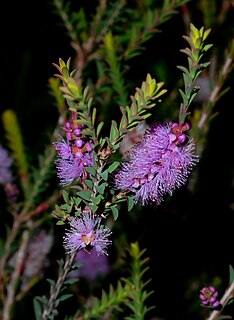
Melaleuca decussata, commonly known as cross-leaf honey-myrtle or totem poles, is a plant in the myrtle family, Myrtaceae native to South Australia and both native and naturalised in Victoria. It is an adaptable shrub, grown in many parts of Australia for its attractive foliage but is regarded as an environmental weed in parts of Victoria.

Calothamnus villosus, commonly known as woolly net-bush or silky net-bush, is a plant in the myrtle family, Myrtaceae and is endemic to the south-west of Western Australia. It is a tall shrub, often forming thickets. It has thin, cylindrical leaves and blood red flowers for many months of the year. It is superficially similar to Calothamnus quadrifidus but can be distinguished from that species by its flowers which have five stamen claws compared to the four of C. quadrifidus.
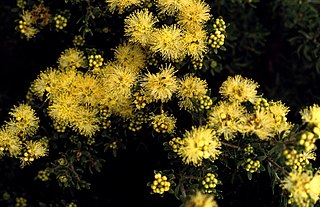
Melaleuca leiopyxis is a shrub in the myrtle family, Myrtaceae and is endemic to an area near the west coast of Western Australia. It has bright yellow flowers and is very similar to Melaleuca depressa. The ranges of the two species overlap making it difficult to distinguish between them.
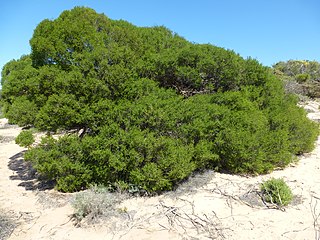
Melaleuca cardiophylla, commonly known as tangling melaleuca or umbrella bush is a plant in the myrtle family, Myrtaceae and is endemic to the west and south-west of Western Australia. It is a dense, prickly shrub with heart-shaped leaves, stamens that are joined in unusually long claw-like bundles, and distinctive, warty fruits.

Melaleuca marginata is a shrub in the myrtle family, Myrtaceae and is endemic to the south-west of Western Australia. It is distinguished by its prickly leaves and its flowers occurring in long sections of the branches. From 1922 to 2011 was known as Melaleuca coronicarpa.

Melaleuca densa is a shrub in the myrtle family, Myrtaceae and is endemic to the south-west of Western Australia. It is a bushy shrub with profuse cream, yellow or greenish flowers and overlapping leaves on the youngest shoots.
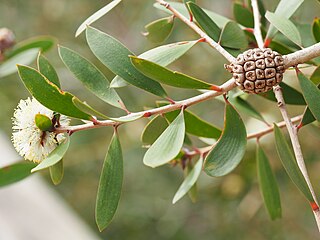
Melaleuca globifera is a shrub in the myrtle family, Myrtaceae and is endemic to the south-west of Western Australia. It is a bushy, small tree with papery bark and spherical heads of flowers on the ends of the branches.

Melaleuca lateriflora, commonly known as gorada, is a plant in the myrtle family, Myrtaceae and is endemic to the south-west of Western Australia. It is usually an erect shrub with oval leaves and small clusters of white flowers mainly along the older branches.

Melaleuca microphylla is a plant in the myrtle family, Myrtaceae and is endemic to a small area in the south-west of Western Australia. It is a bushy shrub with small, crowded leaves and bears a close resemblance to the commonly cultivated Melaleuca ericifolia of the eastern states.

Melaleuca scabra, commonly known as rough honey-myrtle, is a species of shrub that is endemic to a small area on the south coast of Western Australia. It has warty leaves and profuse, pink to purple heads of flowers between July and November.
Melaleuca fulgens subsp. fulgens, commonly known as the scarlet honey myrtle, is a plant in the myrtle family, Myrtaceae and is endemic to the south-west of Western Australia. In 1990, the species Melaleuca fulgens was separated into 3 subspecies and this is the most widespread of them. As with the other two subspecies, this one is notable for its showy flowers which are usually red but its foliage and fruits are also attractive features.

Melaleuca glauca, commonly known as Albany bottlebrush is a plant in the myrtle family, Myrtaceae and is endemic to the south-west of Western Australia. It is a tall shrub with glaucous leaves and spikes of red flowers in spring.
Calothamnus gracilis is a plant in the myrtle family, Myrtaceae and is endemic to the south-west of Western Australia. It is a spreading shrub with upright foliage, common in heath within its range. It has long, thin leaves and produces dark red flowers at different times of the year, depending partly on rainfall. It is similar to Calothamnus gibbosus but lacks the corky bark on the older branches of that species and its flowers and fruit are not as deeply embedded in the bark.
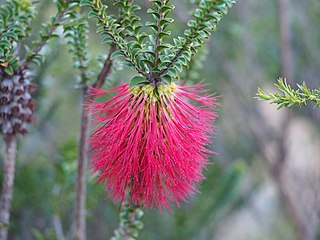
Beaufortia decussata, commonly known as gravel bottlebrush, is a plant in the myrtle family, Myrtaceae and is endemic to the south-west of Western Australia. It has long stems branching only near the upper ends, and scarlet to orange-red flowers in a bottlebrush shape beneath the branches. It was described in John Sims's Edwards Botanical Register as "a very splendid shrub".




















